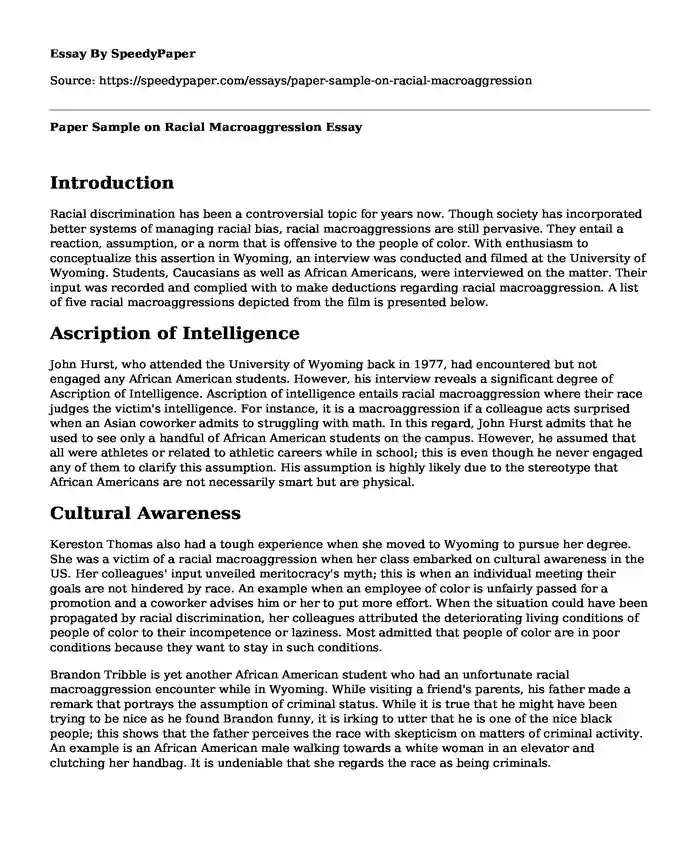
| Type of paper: | Essay |
| Categories: | Racism Culture Discrimination |
| Pages: | 3 |
| Wordcount: | 819 words |
Introduction
Racial discrimination has been a controversial topic for years now. Though society has incorporated better systems of managing racial bias, racial macroaggressions are still pervasive. They entail a reaction, assumption, or a norm that is offensive to the people of color. With enthusiasm to conceptualize this assertion in Wyoming, an interview was conducted and filmed at the University of Wyoming. Students, Caucasians as well as African Americans, were interviewed on the matter. Their input was recorded and complied with to make deductions regarding racial macroaggression. A list of five racial macroaggressions depicted from the film is presented below.
Ascription of Intelligence
John Hurst, who attended the University of Wyoming back in 1977, had encountered but not engaged any African American students. However, his interview reveals a significant degree of Ascription of Intelligence. Ascription of intelligence entails racial macroaggression where their race judges the victim's intelligence. For instance, it is a macroaggression if a colleague acts surprised when an Asian coworker admits to struggling with math. In this regard, John Hurst admits that he used to see only a handful of African American students on the campus. However, he assumed that all were athletes or related to athletic careers while in school; this is even though he never engaged any of them to clarify this assumption. His assumption is highly likely due to the stereotype that African Americans are not necessarily smart but are physical.
Cultural Awareness
Kereston Thomas also had a tough experience when she moved to Wyoming to pursue her degree. She was a victim of a racial macroaggression when her class embarked on cultural awareness in the US. Her colleagues' input unveiled meritocracy's myth; this is when an individual meeting their goals are not hindered by race. An example when an employee of color is unfairly passed for a promotion and a coworker advises him or her to put more effort. When the situation could have been propagated by racial discrimination, her colleagues attributed the deteriorating living conditions of people of color to their incompetence or laziness. Most admitted that people of color are in poor conditions because they want to stay in such conditions.
Brandon Tribble is yet another African American student who had an unfortunate racial macroaggression encounter while in Wyoming. While visiting a friend's parents, his father made a remark that portrays the assumption of criminal status. While it is true that he might have been trying to be nice as he found Brandon funny, it is irking to utter that he is one of the nice black people; this shows that the father perceives the race with skepticism on matters of criminal activity. An example is an African American male walking towards a white woman in an elevator and clutching her handbag. It is undeniable that she regards the race as being criminals.
Cultural Values
Pathologizing cultural values is yet another form of macroaggression that has emerged from the documentary; this is especially true when considering the encounter by an African American student Jasmine Austin. She was baffled that colleagues in her school were surprised by how well she used to dress. Norms and perceptions in society present people of color as inferior in communication, basic etiquette, and how they present themselves. Undoubtedly, they expected Jasmine to be a little fuzzy. An example of this macroaggression is when a Caucasian employee seeks the manager's intervention because a colleague of color speaks too loudly. Or that it is highly unlikely for Caucasians to be homeless or be unhygienic.
When giving her input on how individuals are perceived, Emily Dewett is irked by white students often walking up to her and inquiring who she was. While society can tolerate this, it is highly unlikely that it would be perceived positively when the same question is asked to a Caucasian student; this represents second-class treatment as a macroaggression. Whereby Caucasians are treated with more respect and are prioritized relative to people of color. A perfect analogy for this is when an office serves a white man first despite the African American man having arrived much earlier.
Conclusion
Thus, whether or not the perpetrators of racial macroaggression are aware that their behaviors do not justify the act. Such acts irk victims of the abuse. What is more, norms and perceptions are deeply embedded in the psychology of many individuals, including the victims of the macroaggression. As such, it is difficult to stand up to the abuse. A common mistake a majority of individuals make is avoiding to talk about the issue. As can be seen in Wyoming, individuals often avoided engaging in such controversial debates not to cause a tense situation. And almost all white students would not admit that racism is still an issue in the 21st century. Unfortunately, since most lack cultural awareness while engaging people of color, racial macroaggression instances are often presented. People of color, instances of racial macroaggression are often presented.
Cite this page
Paper Sample on Racial Macroaggression. (2023, Dec 12). Retrieved from https://speedypaper.com/essays/paper-sample-on-racial-macroaggression
Request Removal
If you are the original author of this essay and no longer wish to have it published on the SpeedyPaper website, please click below to request its removal:
- Free Essay on Youth and Politics
- Declaration of the Rights of Men - French Revolution Essay Sample
- Why Is Racial Inequality a Problem? Find the Answer in This Free Essay
- Free Essay Example. National Football League
- Critical Issues in Policing - Free Essay Example
- Essay Example - The Politics of Free Trade Agreements
- Paper Example on The Global Value Chain
Popular categories




